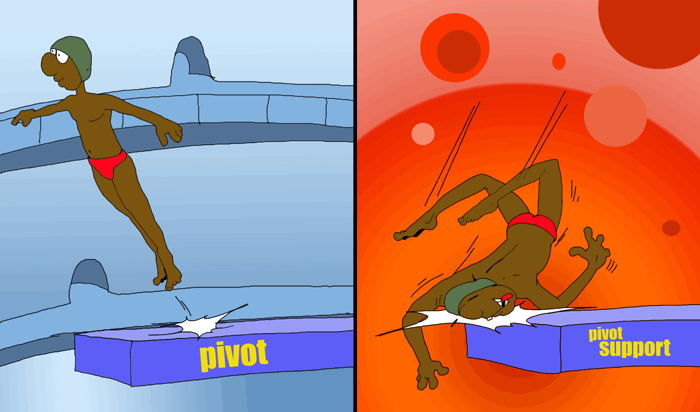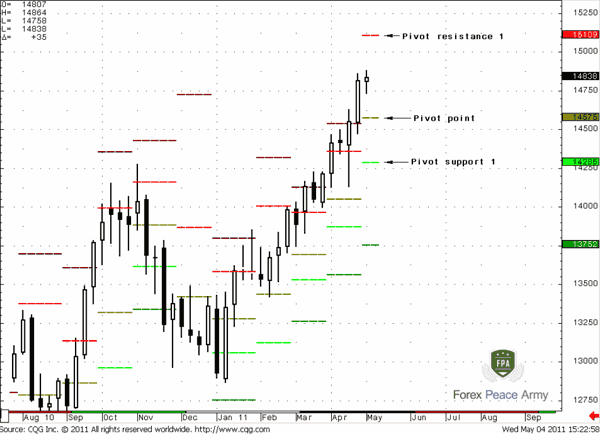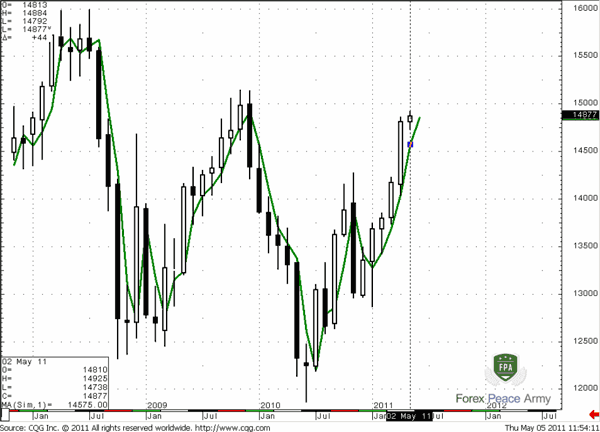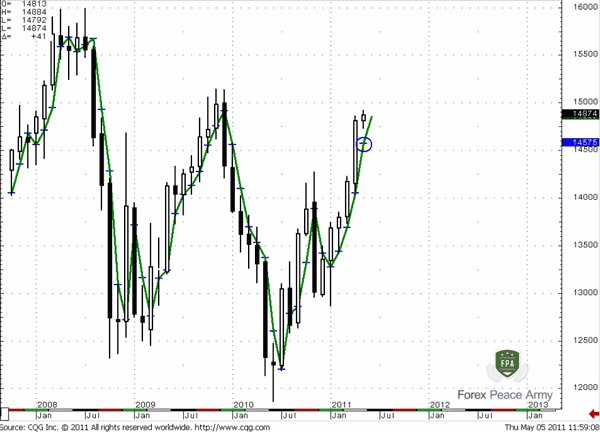Part I. Pivot points – description and calculation

Pivot points look very similar to Fibonacci retracement levels, but have absolutely different calculation algorithm.
Pipruit: And why are they so important?
Commander in Pips: For many reasons:
1. Almost all traders look at them, as with Fibonacci, Pivots are almost a self-fulfilling prophecy. But it happens not only due that reason, but also because the pivot formula has some statistical qualities, that’s why they work.
2. Pivot points could show you where support or resistance could appear in advance. Especially, if they are weekly or monthly pivot points. In this case you know this levels for whole future week or month;
3. Price action around pivot point allows you to judge about market sentiment.
4. Pivot points touches by the market in 70-80% of cases. Other words, it is 70% probability that market will touch the weekly pivot during the week or monthly pivot during the month.

Pipruit: Sounds amazing. And could you show how they look like?
Chart #1 | EUR/USD Weekly and Monthly Pivot points

Pipruit: And why do you show monthly pivots for weekly chart?
Commander in Pips: Because we should use pivots from the 1-step higher time frame. Say, monthly pivots for weekly chart, weekly pivots for daily and daily for intraday charts. It comes from this feature that the higher the time frame – the stronger the pivot points. Second, because each higher period contains number of lower periods, hence pivot of higher time frame works for a number of lower time periods. Say, monthly pivot will be relevant for four weeks.
Pipruit: I see, and why do you call them as “Support 1” and “Resistance 1” could be possible “Support2” and “Resistance 2” or what?
Commander in Pips: Yes, and not only 2, but 3 also. But these levels have less importance and significance. The major importance has pivot point itself, Support 1 and Resistance 1. Another important thing to note is that “support” does not mean that it always will be definitely support, and the same for resistance. These names just tell that support will stand below the market and resistance above it. When and if market will reach it, they could act differently.
Now let’s talk how to calculate them.
Calculation of Pivot points
We will start from pivot point itself, or as it calls just “Pivot”. Also for simplicity lets mark Pivot Point as “PP”, Pivot resistance as “PR” and Pivot Support as “PS”:
Pivot t = (High t-1 + Low t-1 + Close t-1)/3
As you can see I add markings “t” and “t-1”. It means that we should use High, Low and Close price of previous trading period to calculate Pivot for current trading period.
Pipruit: Oh, I see – that’s why you call this indicator as a leading one. We know the High, Low and Close of the previous bar even before the current bar has started. Say, if we talk about the daily time frame, then in the beginning of today’s trading session we’ve already known Pivot point level for it.
Commander in Pips: You’re absolutely right. But as we’ve specified, for the daily time frame we have to use weekly and monthly pivots, hence…
Pipruit: Wait a minute… Week includes five trading days – hence weekly pivot level will be valid for whole coming week, other words – for five future trading sessions! But this is just outstanding issue!
Commander in Pips: Heh, that’s what I mean…
Now, traders usually also calculate Pivot resistance 1, 2 and sometimes 3, and Pivot support 1, 2 and 3. Here are the formulas:
PR1 = 2xPP – Low
PS1 = 2xPP – High
-------------------------------------------
PR2 = PP + (High – Low)
PS2 =PP – (High – Low)
---------------------------------------------
PR3 = High + 2x(PP – Low)
PS3 = Low – 2x(High –PP)
PS1 = 2xPP – High
-------------------------------------------
PR2 = PP + (High – Low)
PS2 =PP – (High – Low)
---------------------------------------------
PR3 = High + 2x(PP – Low)
PS3 = Low – 2x(High –PP)
As you can see, these formulas are very simple when compared to the formulas of some indicators. Still there is some software available that draws these levels automatically. Some software also draws intermediate levels between PP and different PS and PR. But do they really have the same level of significance? Although I can’t take up a position that PS2, PS3 and PR2 and PR3 are quite useless, so as intermediate levels, and maybe you will make a trading system that will be based on these levels, I find that they have quite less importance than PP itself, PS1 and PR1. In general, it is assumed that weekly PS1 and PR1 are low and the high for the coming week. Monthly PS1 and PR1 are low and high for coming month and etc. So, if the market breaks these levels, it tells us about the strength of the market in this direction, and PR2, 3 so as PS 2 and 3 become not so significant.
At the end of this part I would like to give you another way to estimate pivot point for any time frame. Although this method will not allow you to estimate PR or PS, but it could be useful, if your trading software does not have a Pivot Points drawing tool.
You have to plot a 1-period Simple moving average, shift it forward for 1 period and it should be plotted on (H+L+C)/3 basis. Almost any software allows you to do it nowadays.
Let’s check this method:
Here is EUR/USD Monthly chart with such 1x1 DMA on (H+L+C)/3. You can see in the left bottom corner the value of this DMA for the current month – 1.4575.
Now let’s add monthly pivot – take a look at chart #3:
Chart #2 | EUR/USD Monthly chart such 1x1 DMA on (H+L+C)/3

Chart #3 EUR/USD Monthly chart with 1x1 DMA on (H+L+C)/3 and Pivot point tool

See this short blue line – this is monthly PP and it shows the same level – 1.4575. So, it works.

Chart #3 EUR/USD Monthly chart with 1x1 DMA on (H+L+C)/3 and Pivot point tool

Pipruit: Commander, why is Open price is not used in Pivots calculation?
Commander in Pips: Well, today we’ve discussed the most common approach, so called classical calculation of Pivot points, but there are some others that exist and the open price is used sometime. We will discuss it a bit later.
But I’m adherent of the classical approach, because open price as a rule is very near to the close price of the prior trading session, and it looks like that instead of using prices just of last trading session, we add the price of the prior trading session. This distorts the value of Pivot points. Open price in fact, has no time to include all sentiment and price action of last trading session. That’s why the using of Open price looks unnecessary to me.
Still, as we’ve talked million of times here – if you’ll find that calculating of Pivot points with the open price included looks useful for you – then you should use it.
Comments
E
EricBubb
12 years ago,
Registered user
Interesting concept of pivot points have you seen the Murray Maths indicator.
I am getting on very well with the DOSC indicator.
On the same cart I plot the levels for M30/H1, M15, M5 then as the price reaches over sold/under sold I monitor the variouse time frames when M15 and M5 agree I buy/sell and my target is the M30 opposite buy/sell level. :-)
https://www.forexpeacearmy.com/community/attachments/murrey_math-mq4.3848/
I am getting on very well with the DOSC indicator.
On the same cart I plot the levels for M30/H1, M15, M5 then as the price reaches over sold/under sold I monitor the variouse time frames when M15 and M5 agree I buy/sell and my target is the M30 opposite buy/sell level. :-)
https://www.forexpeacearmy.com/community/attachments/murrey_math-mq4.3848/
L
Liquid
12 years ago,
Registered user
MT4 Pivot Point Indy
Here's a link to codebase that has a daily PP indicator.
Daily Pivot Points shifted for different day start time - MQL4 Code Base
Enjoy!
Here's a link to codebase that has a daily PP indicator.
Daily Pivot Points shifted for different day start time - MQL4 Code Base
Enjoy!
Hamza Samiullah
6 years ago,
Registered user
Nice indicator
O
One-fm
5 years ago,
Registered user
Thanks.
Table of Contents
- Introduction
- FOREX - What is it ?
- Why FOREX?
- The structure of the FOREX market
- Trading sessions
- Where does the money come from in FOREX?
- Different types of market analysis
- Chart types
- Support and Resistance
-
Candlesticks – what are they?
- Part I. Candlesticks – what are they?
- Part II. How to interpret different candlesticks?
- Part III. Simple but fundamental and important patterns
- Part IV. Single Candlestick Patterns
- Part V. Double Deuce – dual candlestick patterns
- Part VI. Triple candlestick patterns
- Part VII - Summary: Japanese Candlesticks and Patterns Sheet
-
Mysterious Fibonacci
- Part I. Mysterious Fibonacci
- Part II. Fibonacci Retracement
- Part III. Advanced talks on Fibonacci Retracement
- Part IV. Sometimes Mr. Fibonacci could fail...really
- Part V. Combination of Fibonacci levels with other lines
- Part VI. Combination of Fibonacci levels with candle patterns
- Part VII. Fibonacci Extensions
- Part VIII. Advanced view on Fibonacci Extensions
- Part IX. Using Fibonacci for placing orders
- Part X. Fibonacci Summary
-
Introduction to Moving Averages
- Part I. Introduction to Moving Averages
- Part II. Simple Moving Average
- Part III. Exponential Moving Average
- Part IV. Which one is better – EMA or SMA?
- Part V. Using Moving Averages. Displaced MA
- Part VI. Trading moving averages crossover
- Part VII. Dynamic support and resistance
- Part VIII. Summary of Moving Averages
-
Bollinger Bands
- Part I. Bollinger Bands
- Part II. Moving Average Convergence Divergence - MACD
- Part III. Parabolic SAR - Stop And Reversal
- Part IV. Stochastic
- Part V. Relative Strength Index
- Part VI. Detrended Oscillator and Momentum Indicator
- Part VII. Average Directional Move Index – ADX
- Part VIII. Indicators: Tightening All Together
- Leading and Lagging Indicators
- Basic chart patterns
- Pivot points – description and calculation
- Elliot Wave Theory
- Intro to Harmonic Patterns
- Divergence Intro
- Harmonic Approach to Recognizing a Trend Day
- Intro to Breakouts and Fakeouts
- Again about Fundamental Analysis
- Cross Pair – What the Beast is That?
- Multiple Time Frame Intro
- Market Sentiment and COT report
- Dealing with the News
- Let's Start with Carry
- Let’s Meet with Dollar Index
- Intermarket Analysis - Commodities
- Trading Plan Framework – Common Thoughts
- A Bit More About Personality
- Mechanical Trading System Intro
- Tracking Your Performance
- Risk Management Framework
- A Bit More About Leverage
- Why Do We Need Stop-Loss Orders?
- Scaling of Position
- Intramarket Correlations
- Some Talk About Brokers
- Forex Scam - Money Managers
- Graduation!